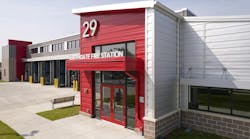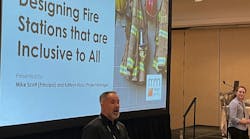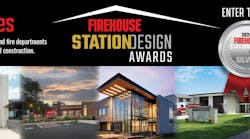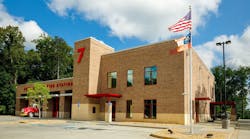The 2022 Station Design Conference had another record-breaking year, with 591 total registrations, including members of public safety agencies, municipal leaders, visitors, and 68 exhibitors. We offered 62 presentations with 74 speakers, including fire, police chiefs, architectural firms, and Ph.Ds.
The goal of the Station Design Conference is to provide programs and resources to help build an effective, operational facility to protect department personnel and better serve the community. We also believe other resources include exhibitors who specialize in public safety services and products and fellow attendees from across North America.
Some returning attendees often ask why several of the presentations are repeated every year. Nearly 85 percent of conference attendees each year are first-time attendees and start new projects for their department. We include the basics of beginning a project—updated each year—and offer a selection of programs for attendees to customize the conference to their department’s needs.
Besides Track 1 and 2 being fire-oriented; Track 3 focuses on law enforcement facilities; and, new this year, Track 4 offered programs on shared facilities, emergency operation centers, EMS facilities, and mental health research. Track 4 topics were in response to requests from last year’s conference attendees.
In case you missed the conference or some of the presentations, here is a selection from my notes:
Ken Newell, Stewart-Cooper-Newell Architects, A Strong Foundation: The Right Start for Your Public Safety Design
- “If you have the chance to buy the adjacent property to your site, buy it today because you can always sell it in the future, but you might need that space in the future.
- “Always make sure there is a good, clear place for citizens to park, otherwise, where do they park? In front of the apparatus bays.”
Craig Carter, BKV Group, Successful Projects Start with a Study
- “We look at savings, so we can demonstrate to the community what you currently have (20 firefighters) and what you will need a number of years out, when you’re going to need space for 40 personnel.”
Lynn Reda, Hughes Group Architects, Building a Strong Foundation: Program Basics
- “Start with a brainstorming session and document those goals and ideas. Reference back to those goals and objectives as you go through the process.”
Susan Gantt, Architects Design Group, Designing Public Safety Facilities for a Changing Climate
- “Concrete is our ‘friend’…and can withstand 150 mph winds…there are products out there that can withstand winds of 250 mph.”
- “Sustainability and Redundancy…you want to have 100 percent redundancy for a full 72 hours of operation; generators that power up the critical…. Water supply – and independent well system and sanitary sewer or holding tanks.”
Jeff Katz, Principal, COAR Group, Renovate or Build New?
- “Upgrading a 60-year-old facility to like-new is very difficult and costly. As an owner, make sure you identify if you are looking for a 5-year, 10-year, 30-year, or 50-year solution because at some point the cost of upgrading an existing facility versus replacement on-site or at a different site clearly tips toward replacement.
Patrick Stone, H2M, Station of the Future: 2055
- "Be proactive, not reactive. Don't just meet the code, exceed it if possible. Understand that codes are based on reactions to unfortunate events and take years to adopt."
- "Lesson for the future - historical design strategies also relate to the future. The transition zones that were once focused on cross-contamination and firefighter cancer awareness have been adapted to address COVID and potential future pandemics with minor alterations. These opportunities can be found throughout the entire station."
We frequently heard references to “building for the future” during the conference. How is it possible to design and build a station to last 50–75 years, while considering the significant changes to the fire and rescue services in the past 10 years?
Theodore (Ted) Galante, The Galante Architecture Studio, Inc., Fire Stations—Past, Present & Future, offered this perspective.
“Since change is a constant in our present world, we need to be open to what is possible in the future. The most successful new ideas or trends become standardized at some point, so best to keep an open mind to see the potential of what is developing. It’s hard to look into a crystal ball and figure out what might be next but planning for 50–75 years and leaving options open for future building occupants is the smartest long-term strategy.”
If you’re thinking or already designing a new fire station, law enforcement facility, or other public safety building, consider attending the 2023 Station Design Conference, May 23–25, in St. Louis, MO. No matter where you are in the process, you will not be disappointed. I promise.








